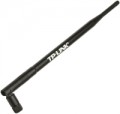The effective angle of coverage of the antenna in the vertical plane, technically — the angle within which the signal power will be at least 50% of the maximum.
For details about the meaning of this parameter, see "HPBW / hor." higher. Here we note that if the antenna is not tilted, then the middle of the covered sector (that is, the line where the signal is most powerful) runs horizontally. Therefore, if another device to be contacted is above or below the antenna, the latter will have to be tilted for maximum communication efficiency. However, absolutely accurate guidance may be required only when receiving a very weak signal on a narrowly directed antenna — in other cases, hitting the HPBW itself is quite enough.
The signal gain provided by the antenna.
In this case, we mean the gain relative to an perfect isotropic radiator — an antenna that uniformly radiates a radio signal in all directions in the form of spherical waves. Such amplification is carried out by narrowing the flow of radio waves, roughly speaking, by increasing their concentration in space (even omnidirectional antennas emit waves not in the form of a sphere, but in the form of a disk). In this case, the coefficient is measured by the maximum power, which is achieved in the centre of the radiation pattern. Note also that the decibel is used to denote this parameter (more precisely, dBi, decibel relative to the isotrope). This is a non-linear unit: for example, a difference of 3 dB corresponds to a difference of approximately 2 times, 10 dB — 10 times, 20 dB — 100 times, etc. There are tables and calculators that allow you to convert decibels to times.
All this means that the gain is a rather specific parameter, and when choosing its optimal value, consultation with special sources or a professional communications operator may be required. However, this is true primarily for specific situations — for example, installing a 3G antenna in a private house a few kilometers from the base station. The general rule is this:
an increase in the gain has a positive effect on the communication range, however, it makes the antenna more susceptible to interference and, usuall
...y, affects its dimensions and weight.
